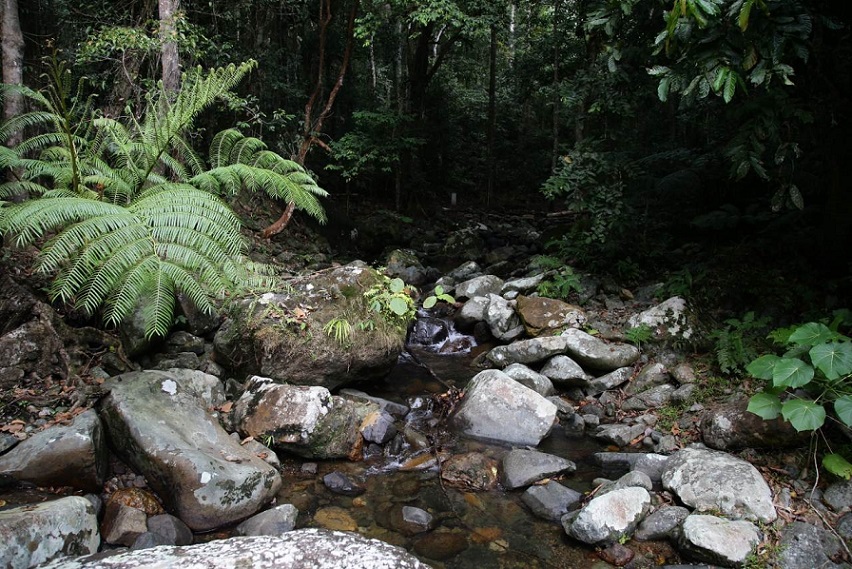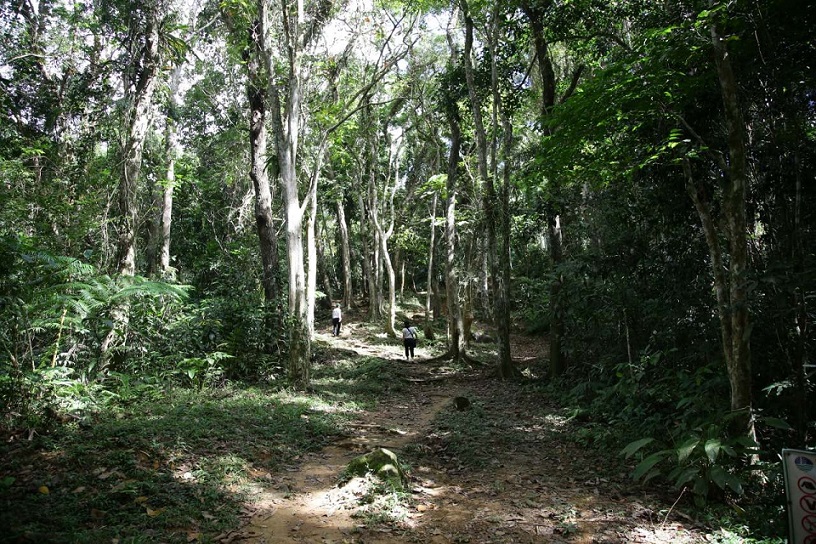
The Lambingan Pool, also called Candi River Pool, is a stream that has become one of the main attractions of the Marinduque Wildlife Sanctuary because of the peace and calm it brings.
BOAC, Marinduque— The hike around a tiny part of the nearly 9,000-hectare Marinduque Wildlife Sanctuary is not easy, especially if you’re forty-something and lack exercise. But Mother Nature will reward you for your effort.
You’ll see a beautiful canopy of leaves if you look up the sky while sitting on a tree trunk as you catch your breath and rest your knees. You’ll hear birds singing and wish this was the symphony in the concrete jungle you live in instead of the roar of buses and jeepneys.
It’s hard to believe that a nature’s paradise exists in place which many associate with poisoned land and waters because of a mining disaster in March 1996.
It was made possible by the 2004 Presidential Proclamation No. 696 which declared the portion of land straddling the municipalities of Boac, Gasan, Buenavista, Torrijos and Sta. Cruz a protected area. It is now known as the “Marinduque Wildlife Sanctuary”.
Among the wildlife in the Sanctuary are the Philippine duck, the green racket tail, the Philippine deer, the cloud rat, the Philippine warty pig, and several bird species like the purple-throated sunbird, Philippine scops owl, brahminy kite, serpent eagle, and zebra dove.
Trees in the forest include molave, yakal, narra, bagtikan, dao, mayapis, ipil, and bagtikan to keep you cool.
Farther up the wildlife sanctuary are homes of a handful of families who have lived there even before the area was declared protected. Their community is called Sitio Isla.
Mostly farmers, they live quiet and simple lives among nature. When they want to connect to the modern world, each house has a satellite dish providing 24 channels for a monthly subscription of P120. They can get National Geographic, Discovery Channel, CNN, and local movies.
The provincial government developed the area into a tourist spot little by little, careful not to disturb and exploit the rare species living here.
In developing the province into a tourism destination, the government had to deal with the stigma of one of the worse mining disasters in the country. But there is much on the island that remains unspoiled.
“I hope they’ll start to think of Marinduque as a tourist destination where they will see the Moriones festival, this wildlife sanctuary, and many other really nice places, and not just the mine spill,” said Joven Lilles, the provincial supervising environmental management specialist and a bird watcher who has documented a number of fauna in the sanctuary.

A variety of tree species can be found at the trail of Marinduque Wildlife Sanctuary, declared as a protected area in 2009. The canopy keeps the sanctuary cool all year round.
At 61, Lilles has been with the provincial government for over two decades. He was among the first on the ground when mine tailings seeped from the damaged Tapian pit of the Marcopper Mining Corporation and made its way into the Boac River. Lilles still remembers the stench of the chemicals.
Twenty-three years later, justice remains elusive for Marinduque’s people and environment as Marcopper and its executives continue to evade responsibility for the mine spill.
But the frustration has not kept Lilles and his provincial government colleagues from working hard to sustain Marinduque’s environmental gems while developing the province’s tourism industry.
“Being an island, Marinduque was able to preserve the endemicity of the species found here,” Lilles said.
Cave assessments, he said, have recently been completed by biologists and a team from the provincial environment and tourism offices.
Lilles said that his team also accompanied the team of Phillip Aviola, the curator of the Museum of Natural History of the University of the Philippines (UP) Los Baños. Their cave explorations led to the discovery of a new kind of frog and an insect bat.
While some of the caves have been recommended for ecotourism, others remain closed for conservation because they have become habitat of rare species, such as the cave-dwelling fresh water shrimp, he said.
Tourist arrivals in Marinduque— an estimated 952 square kilometers heart-shaped island—has been steadily climbing since 2009 with nearly 83,000 travelers visiting the province in 2015. (The figures, however, are lower from 2016 to 2018 after the Department of Tourism began counting only the number of tourists who checked into hotels and not those who stayed with family and friends.)
To get to the island, you take the two to four-hour RoRo (depends on the size and speed of your ship) from Dalahican Port in Lucena, Quezon to Balanacan Port in Mogpog, Marinduque.
Travel bloggers have been smitten by the province’s rustic charms and affordable adventures—from caving, biking, taking a dip in the hot springs and beaches, scuba diving, and trekking. The centuries-old houses and churches, like the Immaculate Conception Cathedral of Boac, are also tourist attractions.
The high-end resort, Bellaroca, whose original owner was Elizabeth Marcos-Keon, sister of the late President Marcos, was popular among the perfumed set but it had to close a few years ago after the only airline that flew in clients canceled its flights to Marinduque. There’s now talk that flights would resume, and some hope Bellaroca could reopen.
The Moriones festival during the Holy Week remains the province’s top crowd drawer. The other two are the “putong/ tubong”, where visitors are crowned and welcomed in an elaborate ceremony, and the other is the “kalutang”, the wooden percussion instruments made from twatingan and bayog trees that can only be found in Marinduque.
There’s more in Marinduque than what we know.
This story is produced by VERA Files under a project supported by the Internews’ Earth Journalism Network, which aims to empower journalists from developing countries to cover the environment more effectively